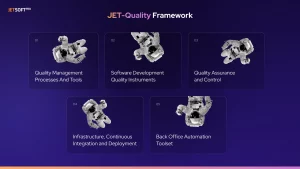In software development, balancing speed and quality can be tricky. Tight deadlines and fast-paced projects often push teams to focus on quick delivery, sometimes at the cost of code quality. While this might seem like a good idea in the short term, it can lead to technical debt, increased maintenance costs, and reduced scalability. Over time, these problems can slow progress and harm team morale and stakeholder trust.
In this blog post, we’ll dive into the concept of the quality of software development, examining what defines high and low quality and how these standards can impact projects. We’ll also discuss effective ways to measure software development quality and share insights into JetSoftPro’s own system for ensuring excellence in every stage of development.
What does quality of software development mean?
Software development quality is a measure of how effectively a product aligns with both technical requirements and the real-world needs of users. Achieving this balance requires a disciplined approach — rigorous planning, comprehensive design, continuous testing, and iterative feedback loops to ensure the final product meets the highest standards.
Quality of software development is a multidimensional concept, which includes:
- Functional Quality: Does the software fulfill its core functions and meet the specified requirements without errors or issues?
- Performance: How does the software handle varying conditions, including different loads and user environments? Does it scale appropriately as demand increases?
- Usability: Is the software user-friendly, intuitive, and easy to navigate for its target audience?
- Security: How well does the software protect user data and defend against vulnerabilities or potential threats?
- Maintainability: How easily can the software be updated, fixed, and scaled over time without introducing new issues?
High-quality vs. low-quality of software development
Quality of software development can be categorized into high-quality and low-quality based on several key attributes. Let’s explore each in detail to understand how they shape the final product and impact the overall success of a project.
High-quality software development is characterized by a commitment to excellence at every stage of the development lifecycle. The key attributes include:
- Comprehensive Testing: High-quality software undergoes extensive testing to ensure it performs as expected in different environments. This includes various types of testing like unit tests, integration tests, and user acceptance tests to catch issues early and ensure smooth operation in real-world scenarios.
- User-Centric Design: The software is designed with the end user in mind. Its interface is intuitive, easy to navigate, and provides a seamless experience. This ensures users can efficiently achieve their goals without frustration.
- Scalability: High-quality software is built with growth in mind. As demand increases, the system is capable of handling more users, larger data sets, and additional features without degrading performance.
- Security: Robust security measures are embedded into the development process. The software is designed to protect user data, prevent breaches, and comply with industry standards to maintain trust and minimize risks.
- Maintainability: The software is designed for long-term sustainability. It features well-organized, clean code that makes updates, bug fixes, and improvements straightforward and cost-effective over time.
In contrast, low-quality software development often lacks attention to detail in key areas, resulting in a cycle of ongoing issues that cost time, money, and customer trust. Key characteristics include:
- Inadequate Testing: Low-quality software development often lacks sufficient testing, leading to undetected bugs that result in system crashes, slowdowns, or failures in functionality when the software is live. This reactive approach to testing can cause significant delays and rework.
- Poor User Experience: The user interface tends to be unintuitive and difficult to navigate. This frustration reduces the software’s effectiveness, lowers user satisfaction, and hinders widespread adoption.
- Limited Scalability: Software built without scalability in mind often struggles to handle growing user demand. As the system is unable to scale efficiently, users experience performance issues.
- Security Vulnerabilities: Low-quality software development typically lacks the necessary security measures, making it vulnerable to cyber threats.
- Hard to Maintain: Without proper documentation and a clear structure, maintaining and enhancing the software becomes difficult and costly, making future updates and bug fixes time-consuming and inefficient.
By prioritizing quality in software development, businesses can avoid these pitfalls and deliver reliable, user-friendly, and secure software.
How can you measure the quality of software development? 7 key metrics
Measuring the quality of software development involves evaluating a range of metrics that determine the software’s effectiveness, reliability, and overall performance. Below are some of the essential metrics used to assess software quality:
Crash Rate
The crash rate measures how frequently a software product unexpectedly stops working, often due to bugs or system overloads. These crashes can disrupt functionality, cause data loss, and negatively impact user experience.
How to calculate: Divide the number of crashes by the number of user sessions, then multiply by 100% to express it as a percentage.

Code Churn Rate
Code churn tracks how often code is added, modified, or deleted in a software project during a specific timeframe. While some level of code churn is normal, excessive changes may signal instability in requirements or an error-prone architecture, increasing the risk of bugs and performance issues.
How to calculate: Add the lines of code added, modified, or deleted during the chosen period, divide by the total lines of code in the project, and multiply by 100 to get the percentage.

Defect Density
Defect density measures the number of defects in a software product relative to its size, typically expressed per 1,000 lines of code. This metric helps evaluate the quality of the codebase, as a higher defect density generally indicates lower quality and more potential issues.
How to calculate: Divide the total number of defects by the total size of the software (e.g., lines of code).
For example, if a project has 10 defects and 20,000 lines of code, the defect density would be 10:20000=0.0005, which means that for every line of code, there is 0.0005 defects.

System Availability
System availability measures the percentage of time a software system is fully operational and accessible for use. A high availability percentage indicates that the system is reliable, minimizing downtime and ensuring users can access it whenever needed.
How to сalculate: Subtract the downtime from the total operational time, then divide that result by the total operational time, and multiply by 100% to get a percentage.

Mean Time to Detect (MTTD)
MTTD measures the average time it takes for a team to identify a failure or defect in a software product after it occurs.
A low MTTD indicates an effective monitoring system that quickly identifies issues, allowing the team to resolve them promptly and minimizing downtime. A high MTTD suggests that the detection process is slow, and the software may require improved testing or monitoring capabilities.
How to calculate: Divide the total time taken to detect all errors by the total number of defects detected during a specific time period.

Mean Time Between Failures (MTBF)
MTBF measures the average time between failures of a system during operation.
A higher MTBF suggests that the software is performing well with fewer disruptions, which is critical in high-stakes industries such as healthcare and aerospace. A decline in MTBF could point to an increase in software failures, potentially due to undetected defects, poor planning, or a breakdown in development and testing processes.
How to сalculate: Divide the total operational time by the number of failures that occurred within that period.

Customer Satisfaction (CSAT)
CSAT measures how satisfied users are with a software product, based on their direct feedback. It’s often measured through surveys where users rate their experience, typically on a scale from “extremely satisfied” to “extremely unsatisfied.”
How to calculate: Divide the number of satisfied customers by the total number of responses, then multiplying by 100% to get a percentage.

JetQuality Framework – JetSoftPro’s automated software development quality control
With 20 years of experience in business process automation, we have developed and implemented the JetQuality Framework — our proprietary, multi-level system designed to ensure in-depth quality control across every stage of software development. This framework is built on industry best practices, providing advanced tools for analysis, forecasting, and a structured quality control process, all while minimizing the risk of human error through automation.
Our JetQuality Framework operates through 5 core quality groups, each focused on key aspects of software development:
- Quality Management Processes and Tools
This group incorporates automated Jira workflows, regular audits, a robust database and application backup strategy, advanced analytics, and continuous improvement metrics. It ensures that all aspects of the development process are thoroughly monitored, with processes in place to identify and address potential issues before they become problems.
- Software Development Quality Instruments
Focusing on the fundamental aspects of software robustness, this group incorporates performance testing, scalability assessments, stress testing, and rigorous security and penetration testing. We also implement predefined manual testing protocols that align with the Product Development Life Cycle (PDLC), ensuring that the software meets both functional and non-functional requirements. The use of quality automation tools further enhances testing accuracy and consistency.
- Quality Assurance & Control
To ensure code reliability and integrity, we employ static code analysis, monitor unit test code coverage, and enforce predefined development conventions. Automated quality metrics gathering, along with detailed reporting, enables real-time tracking of software quality. Our version control practices using GIT and structured code reviews ensure code consistency and maintainability throughout development.
- Infrastructure, Continuous Integration & Deployment
The framework provides a seamless infrastructure setup, automating configuration and deployment processes. By integrating continuous integration (CI) and deployment (CD) pipelines, we ensure that each stage of the software lifecycle is managed efficiently. This allows for rapid iteration and deployment, reducing potential downtime and increasing reliability.
- Back Office Automation Toolset
Beyond development, the JetQuality Framework extends to optimizing back office operations. We automate HR, IT, and financial processes, ensuring that internal workflows align with the same high standards of efficiency and accuracy that we apply to software development.

The JetQuality Framework offers a holistic approach to software development, ensuring that quality is built into every phase of your project. If you’re interested in learning how our framework can optimize your software development process and would like to receive a detailed presentation covering all aspects of the JetQuality Framework, don’t hesitate to contact us.

